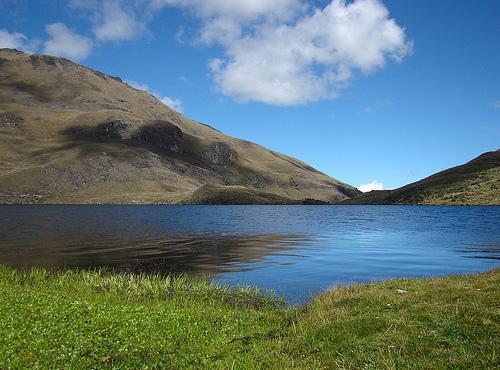

Location: Azuay Province Map
Area: 285.44 km² (28,544 ha)
Cajas National Park known also as Parque Nacional Cajas or simply El Cajas is located in Azuay Province in Ecuador. Cajas National Park covers an area of 285.44 km² (28,544 ha). he name of Cajas National Park is derived from a local dialect of Quichua native tribes and is translated as "cold" or "doorway to snowy mountains". Either way the name fits the description of Ecuadorian highlands. Most of Cajas National Park is located at the elevation between 3100 m and 4450 m above sea level. Dress appropriately since the average temperatures here are 13.2 °C and if you have problems with high altitudes you should take medications to decrease its negative effects.
Hill of Three Crosses
Hill of Three Crosses is one of the highest point in the protected reserve. It serves as a watershed boundary between waters that flows to the Pacific on the Western side and water that flows to the Amazon river and subsequently to the Atlantic Ocean on the Eastern side. The three crosses is devoted to all the lives lost who died in the vicinity of this geological formation.
On the heights of the Western Cordillera de los
Andes, west of the city of Cuenca, there is the Cajas National Park,
formed mainly by large elevations that keep lacustrine systems in
its interior in the form of huge interconnected boxes, hence its
name - Boxes. With the fundamental framework of a parametric
ecosystem, there are more than 1000 bodies of water in the Park,
among which 235 well-defined lagoons located above its extensive
valleys stand out; Among the most important are Luspa, Lagartococha,
Osohuaycu, Mamamag or Taitachungo, Quinoascocha, La Toreadora,
Sunincocha, Cascarillas, Ventanas, Llaviucu, Angas, Ventanas and
Tinguishcocha; This large number of lagoons regulates and preserves
the streams of the area through its drainage. Rivers like the
Tomebamba, the Mazán, the Yanuncay and the Migüir are born in the
Cajas, and provide drinking water to the city of Cuenca. These
rivers are, at the same time, main contributors to the Paute
Hydroelectric Complex, which provides electricity to almost the
entire country.
Thanks to the varied and abundant bodies of
water that make up the park there is also a considerable presence of
migratory birds in the area. This situation, together with the
contribution of the area to the collection and provision of water to
surrounding communities, allowed the place to be recognized as a
Ramsar or Wetland site of International Importance since 2002.
In the area there is no marked regularity of the weather;
Frequent frosts occur and there is a permanent presence of drizzles
(garúa) and fog.
Flora
The plant formations that occur in
the park are: high montane mist forest, high montane evergreen
forest, and herbaceous moor, in which the passage and tourist area
is established. In the eastern limit of the park is a sub-Andean
rain forest (bp-SA), composed mainly of tree species and shrubs with
a great diversity of orchids, ferns and mosses. The forest formation
of Polylepis, qiwuña, "quinoa" or "paper tree" stands out, which is
between 8 and 10 m high, and grows at the edge of the lagoons or
ravines and in rocky places and is the only one tree species above
4,000 meters above sea level. In the western limit, timber species
abound.
The flora that the PNC possesses is biodiverse since
it has ecosystems rich in flora, the most representative species of
the Cajas are grouped in forests that include trees and shrubs of
regular size. We found residual trees of sarar, pichul, yellow, red
quinoa, ferns, moss, orchids of different genera.In general, there
is a record of 600 vascular plant species. The area has come to
represent more than half of the plant biodiversity of the Cuenca
canton.
On the other hand, the effects of human actions,
grazing and burning have degraded some areas of the Park, which
carries out restoration of the most affected parts with plantations
of native grass or Polylepis species.
Wildlife
In the
Cajas the characteristic fauna of the Ecuadorian moors is
registered. There are white-tailed deer, spectacled bear, puma,
yaguarundí, deer of the moor, moor rabbits, the Andean tapir,
muerciélagos, images of the presence of the wolf of the moor have
been registered, as well as the flame has been reintroduced. The
most important birds are the caracara, the condor, the Andean
toucan, ducks and hummingbirds. The Cajas water mouse is an endemic
species of the park. In addition to these species, the Cajas
National Park has species such as: puma, hurí, raposo, chucurillo,
añas, fox, guatusa, augur, deer, yamala, danta, spectacled bear and
bat. 3. Like the northern El Angel Ecological Reserve, the Cajas is
recognized and very popular for its trout.
The Cajas National
Park has 152 species of birds, among these are: hawk, tile, condor,
pajonal pituyo, curiquinga, chaupau, chirote, hawk, among others.
Within these bird species, 8 are considered under threat criteria.
On the other hand, in the mid-40s, the introduction of trout
into the rivers and lagoons of the area to promote sport fishing;
later there was the favorable environment for the development of
aquaculture in the area, mainly in culture pools.
The total
species registered for the Cajas National Park, correspond to 10.3%
of the total species registered in Ecuador.